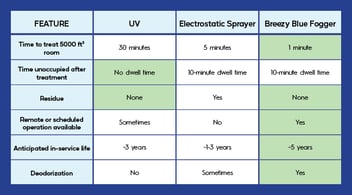
One Step Back, Two Steps Forward: Automating Disinfection
In health care facilities, disinfecting has always been a crucial step. So why change it or automate it instead of sticking with the standard operating procedures that have worked for decades?
When it comes to technology, a lot of people feel like they are taking a step backward, rather than forward. In some cases, this is true. Bringing new tools into a workplace means learning how to use them and taking the time to integrate them into previously established workflows. But by taking some time to learn to use new technology, you can reduce your workload. Automation in the workplace can be incredibly beneficial, especially when replacing laborious tasks with a single press of a button. The idea of bringing in tech scares people for several reasons, but when embraced, workers can become much more efficient. (See a past blog article: Overcoming Fears of Tech: Strategies to Implement Workplace Automation.)
Every person’s time is valuable. Automating tasks with robots and other pieces of technology is supposed to save time, but many people feel reluctant to use them. They are busy and feel like they don't have the time to read lengthy instruction manuals. Additionally, new technology can be confusing, and people are afraid of making mistakes. Workplace technology needs to be simple to learn and use. It should be easy to find the information you need, and the interface should be intuitive. If technology is too difficult to use, people will be less likely to use it, and the time-saving benefits will be lost.
Speeding Up Terminal Cleans in Health Care Facilities
A terminal clean is the thorough and comprehensive cleaning process performed in health care facilities that have been vacated by patients or are being prepared for a new patient. Environmental services (EVS) typically do a terminal clean when a patient is discharged, transferred, or in the event of a contagious outbreak. The primary objective of a terminal clean is to eliminate any potential pathogens and create a safe, clean, and hygienic environment for the next occupant. The process involves meticulous cleaning, disinfection, and sterilization of all surfaces, equipment, and fixtures within the designated area.
Because terminal cleans must be done in a specific way, complex evaluations are needed before innovating or adding new tools to this process. Smart disinfecting foggers, such as Breezy Blue minibots, are tools that some health care facilities are investing in for their terminal cleans. Thorough disinfection takes several minutes to an hour of labor, depending on the size of the room, but Breezy Blue only needs to fog for 30-45 seconds for the same or better results. The full coverage of fog reaches spots that are inconvenient for a person to disinfect, such as ceilings and walls, underneath furniture, and tiny spaces between items.
Implementing Breezy Blue is simple. After cleaning a room, simply position Breezy Blue in the doorway, with the fogger facing the center of the room, and fog for 30 to 45 seconds. Then close the door and leave the disinfectant to settle for at least ten minutes. Afterwards, open the door and turn on the HVAC system to ventilate the room.
Breezy Blue can also be used prior to cleaning to keep EVS safe from the germs that are in the room. In this case, EVS would fog a room, then complete other tasks or fog other rooms while the disinfectant settles, then come back and clean the room without being exposed to pathogens. This extra step ensures workers are also being protected in addition to patients.
Workflow with Breezy Blue

Other disinfecting methods, such as spraying and wiping, take much longer and require hands-on labor. Breezy Blue is a supplemental tool for terminal cleans and regular cleaning procedures, simplifying disinfection while ensuring maximum safety.
Workplace automation has the potential to revolutionize the way people clean and disinfect hospitals, businesses, and other public spaces. While there are still some challenges that need to be addressed, such as the cost of the technology and the need for regular maintenance, automation has the potential to make our jobs safer and healthier. It might feel like taking one step back when learning to use tools like Breezy Blue, but technology moves people forward by making tasks much easier.
For more information and guidelines for using Breezy Blue, check out our Best Practices infographic.




